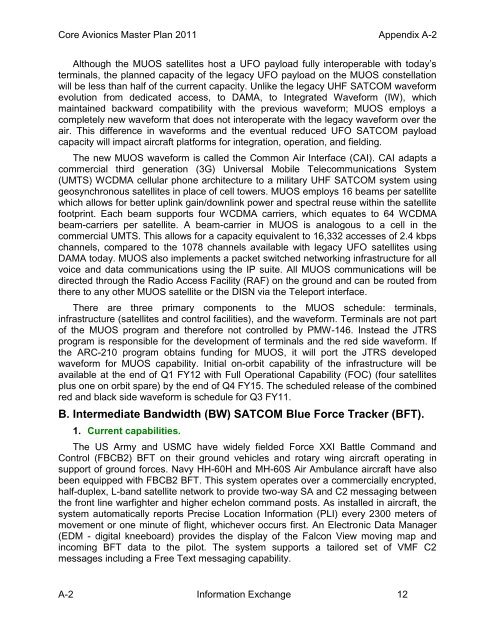Core Avionics Master Plan - NAVAIR - U.S. Navy
Core Avionics Master Plan - NAVAIR - U.S. Navy
Core Avionics Master Plan - NAVAIR - U.S. Navy
- No tags were found...
You also want an ePaper? Increase the reach of your titles
YUMPU automatically turns print PDFs into web optimized ePapers that Google loves.
<strong>Core</strong> <strong>Avionics</strong> <strong>Master</strong> <strong>Plan</strong> 2011 Appendix A-2Although the MUOS satellites host a UFO payload fully interoperable with today‟sterminals, the planned capacity of the legacy UFO payload on the MUOS constellationwill be less than half of the current capacity. Unlike the legacy UHF SATCOM waveformevolution from dedicated access, to DAMA, to Integrated Waveform (IW), whichmaintained backward compatibility with the previous waveform; MUOS employs acompletely new waveform that does not interoperate with the legacy waveform over theair. This difference in waveforms and the eventual reduced UFO SATCOM payloadcapacity will impact aircraft platforms for integration, operation, and fielding.The new MUOS waveform is called the Common Air Interface (CAI). CAI adapts acommercial third generation (3G) Universal Mobile Telecommunications System(UMTS) WCDMA cellular phone architecture to a military UHF SATCOM system usinggeosynchronous satellites in place of cell towers. MUOS employs 16 beams per satellitewhich allows for better uplink gain/downlink power and spectral reuse within the satellitefootprint. Each beam supports four WCDMA carriers, which equates to 64 WCDMAbeam-carriers per satellite. A beam-carrier in MUOS is analogous to a cell in thecommercial UMTS. This allows for a capacity equivalent to 16,332 accesses of 2.4 kbpschannels, compared to the 1078 channels available with legacy UFO satellites usingDAMA today. MUOS also implements a packet switched networking infrastructure for allvoice and data communications using the IP suite. All MUOS communications will bedirected through the Radio Access Facility (RAF) on the ground and can be routed fromthere to any other MUOS satellite or the DISN via the Teleport interface.There are three primary components to the MUOS schedule: terminals,infrastructure (satellites and control facilities), and the waveform. Terminals are not partof the MUOS program and therefore not controlled by PMW-146. Instead the JTRSprogram is responsible for the development of terminals and the red side waveform. Ifthe ARC-210 program obtains funding for MUOS, it will port the JTRS developedwaveform for MUOS capability. Initial on-orbit capability of the infrastructure will beavailable at the end of Q1 FY12 with Full Operational Capability (FOC) (four satellitesplus one on orbit spare) by the end of Q4 FY15. The scheduled release of the combinedred and black side waveform is schedule for Q3 FY11.B. Intermediate Bandwidth (BW) SATCOM Blue Force Tracker (BFT).1. Current capabilities.The US Army and USMC have widely fielded Force XXI Battle Command andControl (FBCB2) BFT on their ground vehicles and rotary wing aircraft operating insupport of ground forces. <strong>Navy</strong> HH-60H and MH-60S Air Ambulance aircraft have alsobeen equipped with FBCB2 BFT. This system operates over a commercially encrypted,half-duplex, L-band satellite network to provide two-way SA and C2 messaging betweenthe front line warfighter and higher echelon command posts. As installed in aircraft, thesystem automatically reports Precise Location Information (PLI) every 2300 meters ofmovement or one minute of flight, whichever occurs first. An Electronic Data Manager(EDM - digital kneeboard) provides the display of the Falcon View moving map andincoming BFT data to the pilot. The system supports a tailored set of VMF C2messages including a Free Text messaging capability.A-2 Information Exchange 12
















